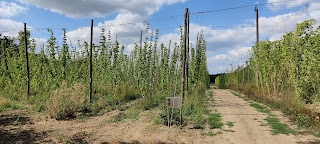 |
| Female hop plant |
 |
| Poles and wires hold the hop bines up |
Then, once harvest starts, there’s several weeks of hectic activity before it quietens down again. One reason for growing several varieties of hops is that they ripen at slightly different times – for example Fuggles is first, then Challenger, followed by Ernest and Bullion, then UK Cascade, and so on – which smooths the harvesting and processing out a bit, but it is still pretty concentrated.
 |
| Male hop plant |
As well as differences in smell and taste, hop varieties also look slightly different on the bine – even before you notice the one in 200 oddities on the farm that are the male hop plants. Challenger cones are longer than Fuggles, for instance, and some kinds are bushier than others – although all were a little thin this year, due to the dry weather. Indeed, this year's hop harvest looks set to be down right across Europe, with Germany predicting a 20% drop.
 |
| A twisting bine |
But climate change is impacting hop-growing in other ways too. For instance, Dom says that traditional English Goldings and Fuggles now need irrigation, whereas the newer varieties are more tolerant.
Anyway, come harvest the whole bine is cut at top and bottom, which only needs two workers on a tractor with a high ‘cherry-picker’ platform on the front. The cut bines go onto a trailer, string and all, and are trucked to a gigantic stripping machine. This separates the vital hop cones from everything else, all of which can go for compost, including the strings.
 |
| Classic 1960s machinery |
Barring the small proportion that goes out green, as garlands or is sent off to be turned into hop pellets, the rest of an average year’s 50 tons of hops goes into the three huge driers – diesel-fuelled, sadly, unlike the rest of the farm which is solar-powered. Several hours at 57ºC drop the moisture content right down, leaving the dried hops ready for packing.
Last on the tour, but far from least, was of course to taste the results. Dom presented us with samples of three different beers, each one made with a specific hop variety from the farm. The two stand-outs were a dank and rich-bodied bitter using Challenger and a smooth, coffee-tinged and herbal-hoppy London Porter made with East Kent Goldings (this turned out to be Five Points’ excellent Railway Porter).And with that, it was time to say thanks and goodbye. At first sight, Hukins Hops doesn’t look the easiest of places to get to (it’s an hour by train out of London Bridge, then a taxi) and the tour does involve quite a lot of walking over uneven ground, but it’s fascinating. But if you can drive you can make a day of it, as there's other places to visit in the area. Old Dairy Brewery (a Hukins customer) is not far and there's vineyards around as well, including several smaller ones alongside better-known ones such as Biddenden and Chapel Down.








